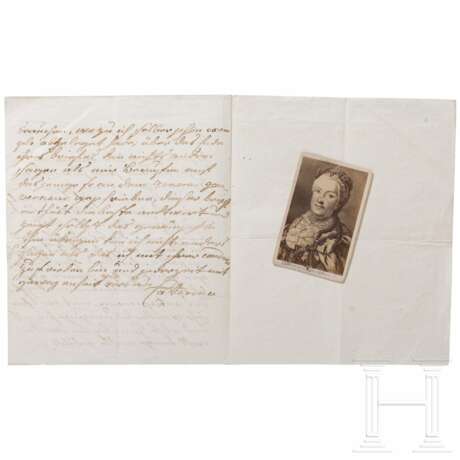Zarin Ekaterina II. (1729 - 1796) - eigenhändiger Brief an ihren Generalquartiermeister Graf von Elmpt
07.05.2024 10:00UTC +01:00
Classic
Starting price
4000EUR € 4 000
| Auctioneer | Hermann Historica |
|---|---|
| Event location | Germany, Grasbrunn / München |
| Buyer Premium | 25 % |
Archive
The auction is completed. No bids can be placed anymore.

ID 1196757
Lot 4218 | Zarin Ekaterina II. (1729 - 1796) - eigenhändiger Brief an ihren Generalquartiermeister Graf von Elmpt
Doppelbogen (Maße 22,5 x 19 cm) mit Wasserzeichen "D & C Blauw". Zwei Seiten in Tinte verfasst, Ekaterina schreibt auf Deutsch: "...Ich habe ihre beyde Briefe wohl erhalten, und habe hierüber am General Gouverneur geschrieben...meine Meinung ist unveruckt das es bey meiner Ukase bleibe und obgenanter brief ist zur befestigung dieser abgefaßet. Im übrigen wünsche ich, das dieser importanter bau ohne hinderungen glücklich zu stande gehe ... Im übrigen kan ich nicht anders sagen als das ich mit ihrer conduite zufrieden bin ... Caterina". Gefaltet. Dazu ein Porträt der Zarin in Visitenkartenformat.
Generalfeldmarschall Ivan Karpovich Graf von Elmpt (1725 Kleve - 1802 Kurland) trat früh in französische Militärdienste und ging 1749 nach Russland. 1755 zum Oberst ernannt, wurde er 1759 im Siebenjährigen Krieg für Tapferkeit ausgezeichnet und zum Brigadier ernannt. 1762 beförderte ihn Zar Peter III. zum Generalmajor und Generalquartiermeister. 1763 erhielt er den St.-Anna-Orden und für die Eroberung Moldawiens, insbesondere für seine Verdienste um die Erstürmung der Festung Chotyn im Feldzug unter Fürst Golizyn, verlieh ihm Ekaterina II. den Alexander-Newsky-Orden. 1796 wurde er General der Infanterie, Kommandeur der Division Livlandsky, Chef des St. Petersburger Grenadier-Regiments, das nach ihm benannt wurde. 1797 ernannte ihn Zar Paul I. zum Generalfeldmarschall und verlieh ihm den St.-Andreas-Orden. 1798 wurde GFM von Elmpt aus der russischen Armee verabschiedet.
Tsarina Ekaterina II (1729 - 1796) – a handwritten letter to her Quartermaster General Count von Elmpt
Tsarina Ekaterina II (1729 - 1796) – a handwritten letter to her Quartermaster General Count von Elmpt
Double sheet measuring 22.5 x 19 cm with a "D & C Blauw" watermark. Two pages written in ink, Ekaterina writes in German (tr.): "...I have received your two letters safely and written to the Governor General about them ... my opinion has not changed, I still insist on my edict and the aforementioned letter is written in confirmation of this matter. I furthermore hope that the construction of this important building will progress without any obstacles ... Incidentally, I cannot express anything but satisfaction with your conduct ... Caterina". Folded. Includes a portrait of the tsarina in calling card format.
Field Marshal Ivan Karpovich Count von Elmpt (1725 Cleves - 1802 Courland) joined the French military service early and went to Russia in 1749. He was appointed Colonel in 1755, honoured for his courage in the Seven Years' War in 1759 and consequently became Brigadier. In 1762, Tsar Peter III promoted him to Major General and Quartermaster General. In 1763, he received the Order of Saint Anna, and Catherine II awarded him the Order of Alexander Nevsky for the conquest of Moldavia, especially due to his contribution to the storming of Khotyn Fortress in the campaign led by Prince Golitsyn. In 1796, he became Infantry General, Commander of the Livlandsky Division, Chief of the Saint Petersburg Grenadier Regiment, which was named after him. In 1798, Tsar Paul I appointed him Field Marshal and awarded him the Order of Saint Andrew. Von Elmpt retired from the Russian army in 1798.
Condition: II
| Address of auction |
Hermann Historica Bretonischer Ring 3 85630 Grasbrunn / München Germany | ||||||||||||||
|---|---|---|---|---|---|---|---|---|---|---|---|---|---|---|---|
| Preview | |||||||||||||||
| Phone | +49 (0)89 5472 649 0 | ||||||||||||||
| Fax | +49 (0)89 5472 64999 | ||||||||||||||
| Buyer Premium | 25 % | ||||||||||||||
| Conditions of purchase | Conditions of purchase | ||||||||||||||
| Business hours | Business hours
|


